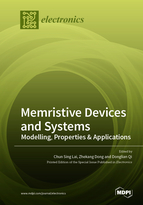Memristive Devices and Systems: Modelling, Properties & Applications
A special issue of Electronics (ISSN 2079-9292). This special issue belongs to the section "Computer Science & Engineering".
Deadline for manuscript submissions: closed (1 October 2022) | Viewed by 28540
Special Issue Editors
Interests: smart energy management; smart grids; smart battery management systems; power system optimization; energy system modeling; data analytics; electric vehicle systems; hybrid powertrains optimization; energy economics for renewable energy and storage systems
Special Issues, Collections and Topics in MDPI journals
Interests: computer-in-memory devices; nanoelectronics; VLSI; neuromorphic systems
Interests: power equipment defect perception; active distribution network control and protection; multi-agent cluster control; smart grid
Special Issues, Collections and Topics in MDPI journals
Special Issue Information
Dear Colleagues,
The memristor is considered to be a promising candidate for next-generation computing systems due to its nonvolatility, high density, low power, nanoscale geometry, nonlinearity, binary/multiple memory capacity, and negative differential resistance. Novel computing architectures/systems based on memristors have shown great potential to replace the traditional von Neumann computing architecture, which faces data movement challenges. With the development of material science, novel preparation and modeling methods for different memristive devices have been put forward recently, which opens up a new path for realizing different computing systems/architectures with practical memristor properties. The purpose of this Special Issue on “Memristive Devices and Systems: Modeling, Properties, and Applications” is to provide a comprehensive overview of key computational primitives enabled by these memory devices as well as their applications, spanning edge computing, signal processing, optimization, machine learning, deep learning, stochastic computing, and so on.
Dr. Chun Sing Lai
Dr. Zhekang Dong
Prof. Dr. Donglian Qi
Guest Editors
Manuscript Submission Information
Manuscripts should be submitted online at www.mdpi.com by registering and logging in to this website. Once you are registered, click here to go to the submission form. Manuscripts can be submitted until the deadline. All submissions that pass pre-check are peer-reviewed. Accepted papers will be published continuously in the journal (as soon as accepted) and will be listed together on the special issue website. Research articles, review articles as well as short communications are invited. For planned papers, a title and short abstract (about 100 words) can be sent to the Editorial Office for announcement on this website.
Submitted manuscripts should not have been published previously, nor be under consideration for publication elsewhere (except conference proceedings papers). All manuscripts are thoroughly refereed through a single-blind peer-review process. A guide for authors and other relevant information for submission of manuscripts is available on the Instructions for Authors page. Electronics is an international peer-reviewed open access semimonthly journal published by MDPI.
Please visit the Instructions for Authors page before submitting a manuscript. The Article Processing Charge (APC) for publication in this open access journal is 2400 CHF (Swiss Francs). Submitted papers should be well formatted and use good English. Authors may use MDPI's English editing service prior to publication or during author revisions.
Keywords
- memristive device preparation
- memristive device modeling and analysis
- novel electronic devices that show memristive properties
- novel memristive circuit design solutions for neuromorphic systems
- memristive circuit fault diagnosis and analysis
- memristive systems for different applications (e.g., edge computing, signal processing, optimization, machine learning, deep learning, and stochastic computing)
- nonvolatile memory solutions with computing capabilities
- and memory devices and systems for in-memory computing








